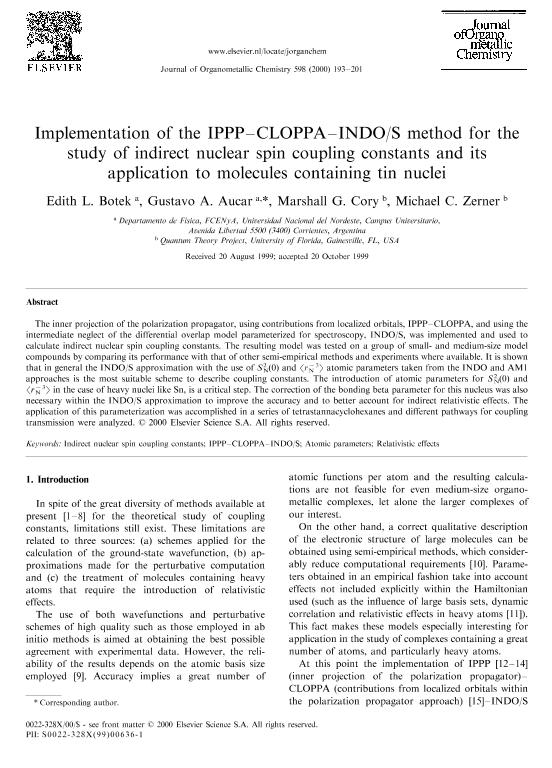Mostrar el registro sencillo del ítem
dc.contributor.author
Botek, Edith L.
dc.contributor.author
Aucar, Gustavo Adolfo

dc.contributor.author
Cory, Marshall G.
dc.contributor.author
Zerner, Michael C.
dc.date.available
2017-08-11T22:54:05Z
dc.date.issued
2000-03
dc.identifier.citation
Botek, Edith L.; Aucar, Gustavo Adolfo; Cory, Marshall G.; Zerner, Michael C.; Implementation of the IPPP–CLOPPA–INDO/S method for the study of indirect nuclear spin coupling constants and its application to molecules containing tin nuclei; Elsevier Science Sa; Journal of Organometallic Chemistry; 598; 2; 3-2000; 193-201
dc.identifier.issn
0022-328X
dc.identifier.uri
http://hdl.handle.net/11336/22283
dc.description.abstract
The inner projection of the polarization propagator, using contributions from localized orbitals, IPPP–CLOPPA, and using the intermediate neglect of the differential overlap model parameterized for spectroscopy, INDO/S, was implemented and used to calculate indirect nuclear spin coupling constants. The resulting model was tested on a group of small- and medium-size model compounds by comparing its performance with that of other semi-empirical methods and experiments where available. It is shown that in general the INDO/S approximation with the use of S N 2 (0) and r N −3 atomic parameters taken from the INDO and AM1 approaches is the most suitable scheme to describe coupling constants. The introduction of atomic parameters for S N 2 (0) and r N −3 in the case of heavy nuclei like Sn, is a critical step. The correction of the bonding beta parameter for this nucleus was also necessary within the INDO/S approximation to improve the accuracy and to better account for indirect relativistic effects. The application of this parameterization was accomplished in a series of tetrastannacyclohexanes and different pathways for coupling transmission were analyzed.
dc.format
application/pdf
dc.language.iso
eng
dc.publisher
Elsevier Science Sa

dc.rights
info:eu-repo/semantics/openAccess
dc.rights.uri
https://creativecommons.org/licenses/by-nc-nd/2.5/ar/
dc.subject
Indo/S
dc.subject
Tin
dc.subject
Indirect Nuclear Spin Coupling Constants
dc.subject
Ippp–Cloppa–Indo/S
dc.subject
Atomic Parameters
dc.subject
Relativistic Effects
dc.subject.classification
Otras Ciencias Físicas

dc.subject.classification
Ciencias Físicas

dc.subject.classification
CIENCIAS NATURALES Y EXACTAS

dc.title
Implementation of the IPPP–CLOPPA–INDO/S method for the study of indirect nuclear spin coupling constants and its application to molecules containing tin nuclei
dc.type
info:eu-repo/semantics/article
dc.type
info:ar-repo/semantics/artículo
dc.type
info:eu-repo/semantics/publishedVersion
dc.date.updated
2017-08-04T15:40:51Z
dc.journal.volume
598
dc.journal.number
2
dc.journal.pagination
193-201
dc.journal.pais
Países Bajos

dc.journal.ciudad
Amsterdam
dc.description.fil
Fil: Botek, Edith L.. Universidad Nacional del Nordeste. Facultad de Ciencias Exactas Naturales y Agrimensura; Argentina
dc.description.fil
Fil: Aucar, Gustavo Adolfo. Universidad Nacional del Nordeste. Facultad de Ciencias Exactas Naturales y Agrimensura; Argentina. Consejo Nacional de Investigaciones Científicas y Técnicas; Argentina
dc.description.fil
Fil: Cory, Marshall G.. University of Florida; Estados Unidos
dc.description.fil
Fil: Zerner, Michael C.. University of Florida; Estados Unidos
dc.journal.title
Journal of Organometallic Chemistry

dc.relation.alternativeid
info:eu-repo/semantics/altIdentifier/url/https://doi.org/10.1016/S0022-328X(99)00636-1
dc.relation.alternativeid
info:eu-repo/semantics/altIdentifier/url/http://www.sciencedirect.com/science/article/pii/S0022328X99006361
Archivos asociados
